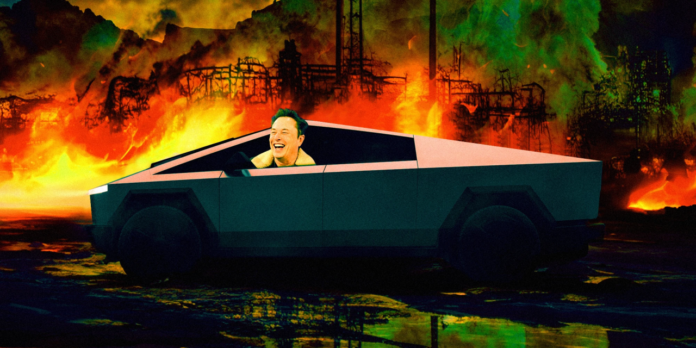This Content Is Only For Subscribers
In most regards, the sales pitch for Tesla’s new Cybertruck doesn’t differ in its particulars from the value proposition of any other pickup or SUV. It’s intended to be tough — heavy, high, sharp-edged steel. “If you’re ever in an argument with another car,” Elon Musk assured everyone at the truck’s launch event last week, “you will win.” Never mind that a head-on crash at only 35 mph appears to be enough to crush the truck’s front and break its rear axle.
But unlike the Cybertruck, its sales pitch has a curve: Musk has said all along that it’s designed to be your go-to vehicle for the End of the World. “Sometimes you get these late-civilization vibes,” he explained at the launch. “The apocalypse could come along at any moment, and here at Tesla we have the finest in apocalypse technology.”
As many observers pointed out, that seems kind of silly. After things fall apart and the shopping center does not hold, where are you going to charge an electric car? But while it’s easy to drag Musk for his weirdo millenarianism, let’s pause for a moment and take him at his word. He thinks his hideously complex, electrically powered, factory-engineered technological apex predator will not only continue to function after a societal collapse — nuclear armageddon, sea-level rise, global pandemic, all the hits — but actually be of some use. In his mind, at least, the Cybertruck will get us where we need to go long after there’s no more cyber.
That says something important about Musk and the flavor of apocalypse he thinks is coming. Apparently Musk believes that if and when the end comes, he — and presumably every Cybertruck owner — will be safe in some sort of armored dome, where the lights are still on and the champagne’s on tap. The rest of us suckers? Not so much. As one wag snarked on a social network that Musk does not own, “Musk is rich enough that his conception of an apocalypse is something that will affect normal people and not him.”
But Musk’s view of the future is even more dystopian than that. The Cybertruck is essentially built for postapocalypse tourism — for leaving the gun-studded armor-dome arcology to go shopping in the plague-ridden dystopian city, maybe do a little glamping on the iridescently toxic beach beyond the radioactive waste. It’ll be fun to visit those places, because owning a Cybertruck will mean you’re rich enough to not have to live there. If you believe in an apocalypse with trucks, you must also believe that someone will be maintaining the necessary infrastructure. And that they’ll be working for you.
It’s always hard to know whether Musk means what he’s saying; he’s kind of an epistemological chasm. But the dude has apocalypses on the brain. He has asserted that “it’s just a matter of time” until there’s another asteroid extinction event like the one that wiped out the dinosaurs (potentially true), that low birth rates pose a “bigger risk to civilization than global warming” (not true), and that a “woke mind virus” is the reason San Francisco looks like it has suffered a zombie apocalypse (very not true). He started SpaceX because he hopes to make humanity multiplanetary as a “backup” in the event of a terrestrial calamity, like Earth getting engulfed by its expanding sun (something that won’t happen for at least 5 billion years). But lately the apocalypse that’s most preoccupied Musk is the one where artificial intelligence becomes powerful enough to take over the world and kill all humans. That led him to start Neuralink, a brain-computer-interface company with an eye on letting humans intermingle with AI, and to cofound OpenAI, which in a twist only ChatGPT could love has pivoted to creating an artificial intelligence powerful enough to take over the world and kill all humans.
The apocalyptic mindset dovetails conveniently with Musk’s love of longtermism, an ideology that says you’re allowed to do pretty much anything you want right now as long as it saves trillions of lives in the distant future. Hence the Cybertruck, the ultimate status symbol for the end times. If you’re looking to justify an apocalyptic world in which you tool around in a $61,000 pickup truck while everyone else eats their young, then this is the vehicle for you. Sure, all those losers crammed into a 265th-floor walkup in Megacity One will be jealous as you cruise past them in your sweet, sweet ride. But all they’re doing is surviving. Your job — your mission, really — is to ensure the continuation of human civilization. And to do that, you’re going to need something with armored glass, a 2,500-pound payload, and an interior “as quiet as outer space.”
The irony is that if you really want something apocalyptic — something that has killed or maimed millions, that remade the landscape into something inhuman and bleak, that grew out of a devilish bargain promising freedom and delivering fear — well, we already have that. It’s trucks! Barely two weeks before the Cybertruck launch, the Insurance Institute for Highway Safety published new data confirming what car researchers have been saying for years. Trucks are 45% more likely to kill a person they hit than smaller vehicles. Places with more trucks have more pedestrian deaths, as do cities with more roads and less public transit. The nation’s pedestrian death toll has soared by 80% since 2009, thanks in large part to ever rising truck sizes andsales. That’s 20 dead people every day. And that’s not counting all the air pollution and deforestation and global warming that trucks are helping to fuel. The truckpocalypse is now.
In the early 20th century, when cars first came within financial reach of average Americans, the sales pitch focused on freedom of movement. But with trucks, the marketing has changed. Giant trucks represent security, the cocooned safety of the passengers against an increasingly hostile world. The Cybertruck takes this idea to its logical, lolsob hilarious extreme. It doesn’t just park inside the armor dome; it is the armor dome. And to make that sales pitch stick, the people hawking the trucks have to make us believe that the world is, in fact, getting increasingly hostile. Make sure everyone can buy a gun, then sell everyone a bulletproof car.
Writers from Ursula K. Le Guin to Ken Liu have variously phrased the idea that every dystopia is, inevitably, someone else’s utopia. When a spaceship-building, Mars-settlement-advocating, right-wing-politics-curious richest man on Earth starts telling you to consider what you’ll drive amid late-civilization vibes, it’s worth asking where he’s planning on riding out the end days himself. My brain is even more sci-fi-addled than Musk’s, so I know that cyberpunk — the genre with which his ridiculous truck identifies — is about the dangers of amok technology in a world crushed by inequality. To paraphrase the game designer Mike Pondsmith: Cyberpunk is a warning, not an owner’s manual.
Besides, the perfect postapocalyptic vehicle isn’t a big ugly truck. It’s a bicycle — light, reliable, easy to fix and scavenge parts for, able to move cargo, doesn’t need any power except you and calories. And the thing that will actually get us through an apocalypse — or, preferably, prevent one — isn’t driving a steel-plated War Rig. It’s working together. Cooperation has always been humanity’s superpower, when we remember to use it. The real armor dome is the friends we make along The Road.
SOURCE: Business Insyder Africa





